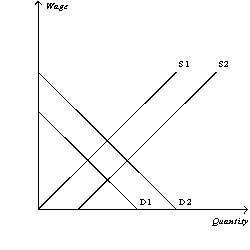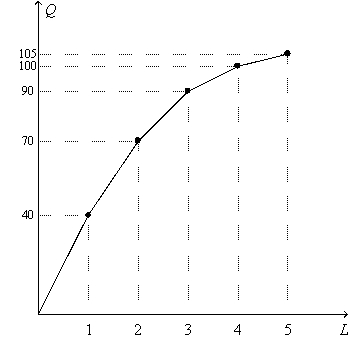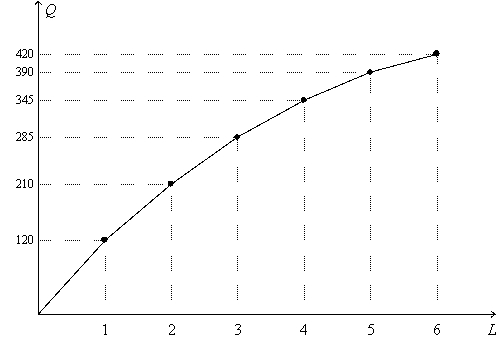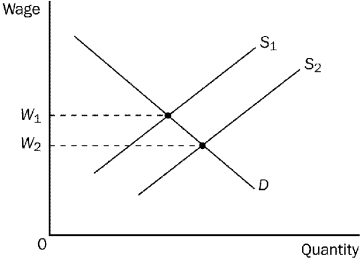A) marginal product of labor will decrease.
B) value of the marginal product of labor will decrease.
C) value of the marginal product of labor will increase.
D) final product price will increase.
F) B) and D)
Correct Answer

verified
Correct Answer
verified
Multiple Choice
The effect of the Black Death in 14th-century Europe was to
A) decrease wages.
B) increase land rents.
C) reduce income inequality between peasants and the landed classes.
D) Both a and b are correct.
F) A) and D)
Correct Answer

verified
Correct Answer
verified
Multiple Choice
Figure 18-6  -Refer to Figure 18-6.The graph above illustrates the market for bakers who make homemade breads and breakfast pastries.If the bakery profession becomes more attractive to young women and men because of a new reality television show,what happens in the market for bakers?
-Refer to Figure 18-6.The graph above illustrates the market for bakers who make homemade breads and breakfast pastries.If the bakery profession becomes more attractive to young women and men because of a new reality television show,what happens in the market for bakers?
A) Demand increases from D1 to D2.
B) Demand decreases from D2 to D1.
C) Supply increases from S1 to S2.
D) Supply decreases from S2 to S1.
F) A) and C)
Correct Answer

verified
Correct Answer
verified
Multiple Choice
A competitive firm will hire workers up to the point at which the value of the marginal product of labor equals the
A) average total cost.
B) average variable cost.
C) wage.
D) price per unit of output.
F) B) and D)
Correct Answer

verified
Correct Answer
verified
Multiple Choice
Which of the following events would shift a labor supply curve? (i) Immigration of high-skilled workers (ii) Immigration of low-skilled workers (iii) Changes in the number of women willing to work full time
A) (i) and (iii) only
B) (ii) and (iii) only
C) (iii) only
D) (i) , (ii) ,and (iii)
F) A) and C)
Correct Answer

verified
Correct Answer
verified
Multiple Choice
Table 18-10
Consider the following daily production data for Caroline's Cookies,Inc.Caroline's sells cookies for $2.50 each and pays the workers a wage of $325 per day.
 -Refer to Table 18-10.What is the marginal profit of the fourth worker?
-Refer to Table 18-10.What is the marginal profit of the fourth worker?
A) $25
B) $117
C) $350
D) $1,700
F) All of the above
Correct Answer

verified
Correct Answer
verified
Multiple Choice
Table 18-9
 -Refer to Table 18-9.This table describes the number of baseballs a manufacturer can produce per day with different quantities of labor.Each baseball sells for $5 in a competitive market.For which level of employment is the marginal product of labor greatest?
-Refer to Table 18-9.This table describes the number of baseballs a manufacturer can produce per day with different quantities of labor.Each baseball sells for $5 in a competitive market.For which level of employment is the marginal product of labor greatest?
A) 1 worker
B) 2 workers
C) 3 workers
D) 4 workers
F) All of the above
Correct Answer

verified
Correct Answer
verified
Multiple Choice
Figure 18-2
The figure below shows the production function for a particular firm.  -Refer to Figure 18-2.The marginal product of the fourth worker is
-Refer to Figure 18-2.The marginal product of the fourth worker is
A) 100 units.
B) 25 units.
C) 20 units.
D) 10 units.
F) B) and D)
Correct Answer

verified
Correct Answer
verified
Multiple Choice
Consider the market for medical doctors.Suppose the opportunity cost of going to medical school decreases for many individuals.Suppose it generally takes about ten years to become a practicing doctor.Holding all else constant,in ten years the equilibrium wage for doctors will
A) increase.
B) decrease.
C) not change.
D) It is not possible to determine what will happen to the equilibrium wage.
F) A) and B)
Correct Answer

verified
Correct Answer
verified
Multiple Choice
When labor supply increases,
A) the marginal productivity of workers always increases.
B) profit-maximizing firms reduce employment.
C) wages increase as long as labor supply is upward sloping.
D) wages decrease as long as labor demand is downward sloping.
F) None of the above
Correct Answer

verified
Correct Answer
verified
Multiple Choice
Figure 18-1.On the graph,L represents the quantity of labor and Q represents the quantity of output per week.  -Refer to Figure 18-1.Suppose the firm sells its output for $25 per unit,and it pays each of its workers $1,000 per week.Also,the firm's non-labor costs are fixed and they amount to $2,000.The firm maximizes profit by hiring
-Refer to Figure 18-1.Suppose the firm sells its output for $25 per unit,and it pays each of its workers $1,000 per week.Also,the firm's non-labor costs are fixed and they amount to $2,000.The firm maximizes profit by hiring
A) 2 workers.
B) 3 workers.
C) 4 workers.
D) 5 workers.
F) C) and D)
Correct Answer

verified
Correct Answer
verified
Multiple Choice
Suppose that the wage paid to workers who detassel corn rises.What happens in the market for workers who weed soybean fields,given that workers who detassel corn can easily work weeding soybean fields?
A) The demand curve for soybean workers increases.
B) The demand curve for soybean workers decreases.
C) The supply curve for soybean workers increases.
D) The supply curve for soybean workers decreases.
F) None of the above
Correct Answer

verified
Correct Answer
verified
Multiple Choice
Figure 18-7  -Refer to Figure 18-7.When the relevant labor supply curve is S1,and the labor market is in equilibrium,the
-Refer to Figure 18-7.When the relevant labor supply curve is S1,and the labor market is in equilibrium,the
A) wage is W1.
B) opportunity cost of leisure to workers is W1.
C) value of the marginal product of labor to firms is W1.
D) All of the above are correct.
F) A) and C)
Correct Answer

verified
Correct Answer
verified
Multiple Choice
Rosie's Flower Shop sells bouquets of roses for $15 each.If Rosie hires 10 workers,she can sell 500 bouquets per week.If she hires 11 workers,she can sell 560 bouquets per week.Rosie pays each of her workers $400 per week.Which of the following is correct?
A) For the 11th worker,the marginal profit is $500.
B) For the 11th worker,the marginal revenue product is $500.
C) The firm is maximizing its profit.
D) If the firm is employing 11 workers,then its profit would increase if it cut back to 10 workers.
F) All of the above
Correct Answer

verified
Correct Answer
verified
Multiple Choice
Which of the following is true at the level of output at which a competitive firm maximizes profit?
A) price = marginal cost
B) price = wage/value of marginal product of labor
C) price = marginal product of labor/wage
D) All of the above are correct.
F) B) and C)
Correct Answer

verified
Correct Answer
verified
Multiple Choice
Consider the market for medical doctors.Suppose the opportunity cost of going to medical school decreases for many individuals.Suppose it generally takes about ten years to become a practicing doctor.Holding all else constant,in ten years the equilibrium quantity of doctors will
A) increase.
B) decrease.
C) not change.
D) It is not possible to determine what will happen to the equilibrium quantity.
F) None of the above
Correct Answer

verified
Correct Answer
verified
True/False
For profit-maximizing,competitive firms,the demand curve for each factor of production equals the value of the marginal product of that factor.
B) False
Correct Answer

verified
Correct Answer
verified
Multiple Choice
Wendy's hourly wage decreases from $15 to $12.Which of the following describes a consequence of the decrease in Wendy's wage?
A) The opportunity cost of Wendy's leisure time has decreased.
B) Wendy may choose to work more hours due to the decrease in her wage.
C) Wendy may choose to work fewer hours due to the decrease in her wage.
D) All of the above are correct.
F) All of the above
Correct Answer

verified
Correct Answer
verified
Multiple Choice
Table 18-6
 -Refer to Table 18-6.The fact that the production function exhibits diminishing marginal productivity implies that
-Refer to Table 18-6.The fact that the production function exhibits diminishing marginal productivity implies that
A) total production decreases beyond a certain level of output.
B) labor markets are not always competitive.
C) the additions to total output get smaller as more workers are hired.
D) marginal profit is negative.
F) All of the above
Correct Answer

verified
Correct Answer
verified
Multiple Choice
Table 18-5
 -Refer to Table 18-5.What is the value for the cell labeled CC?
-Refer to Table 18-5.What is the value for the cell labeled CC?
A) 650
B) 600
C) 100
D) 50
F) A) and D)
Correct Answer

verified
Correct Answer
verified
Showing 61 - 80 of 477
Related Exams